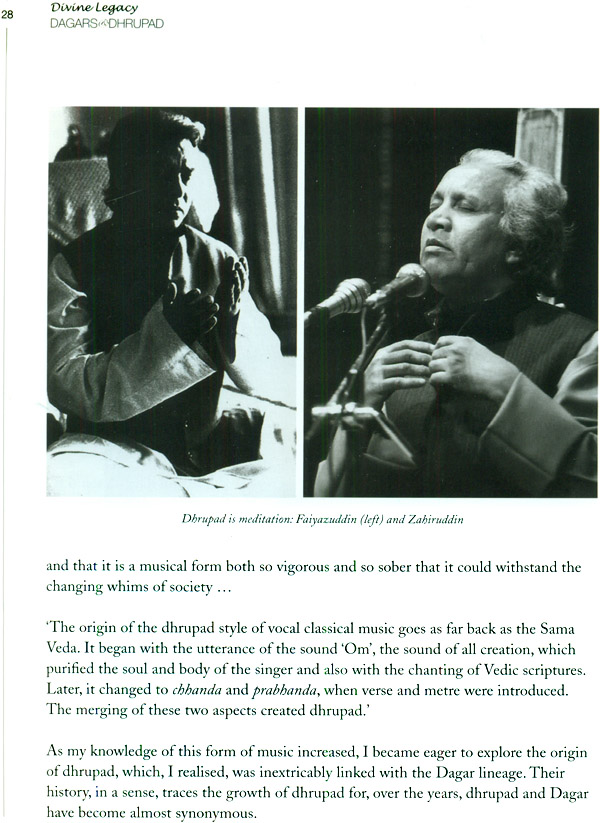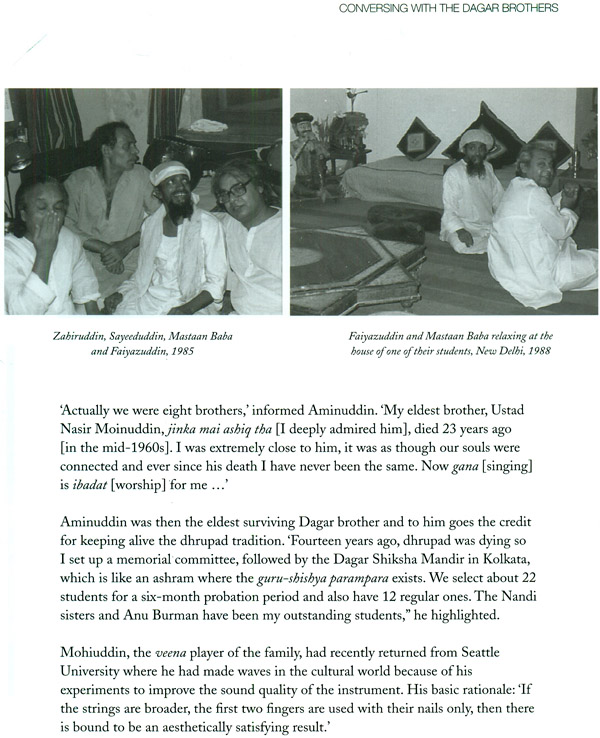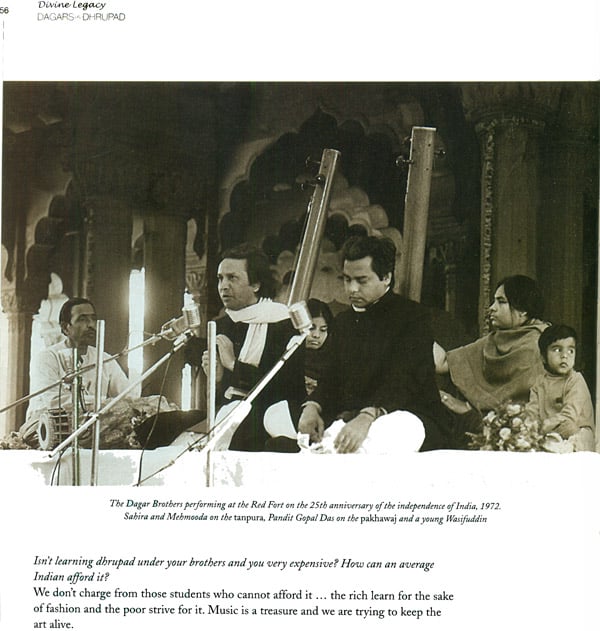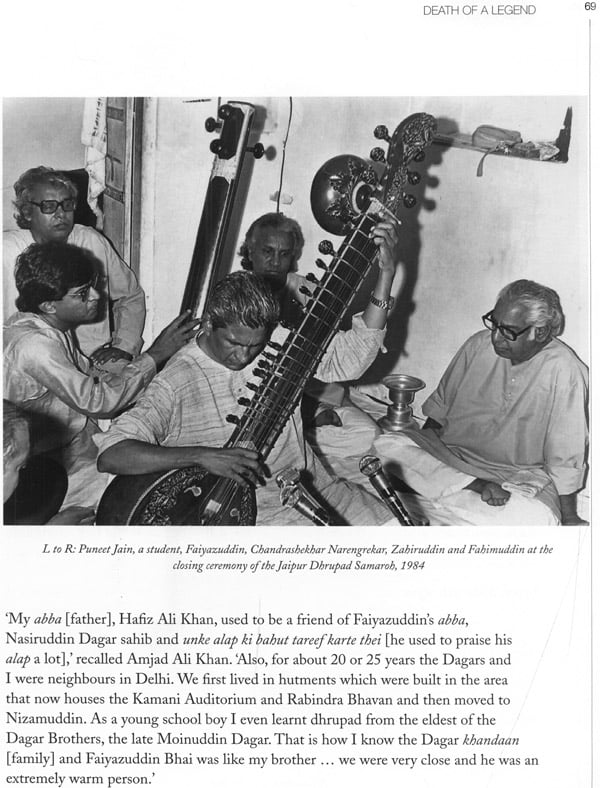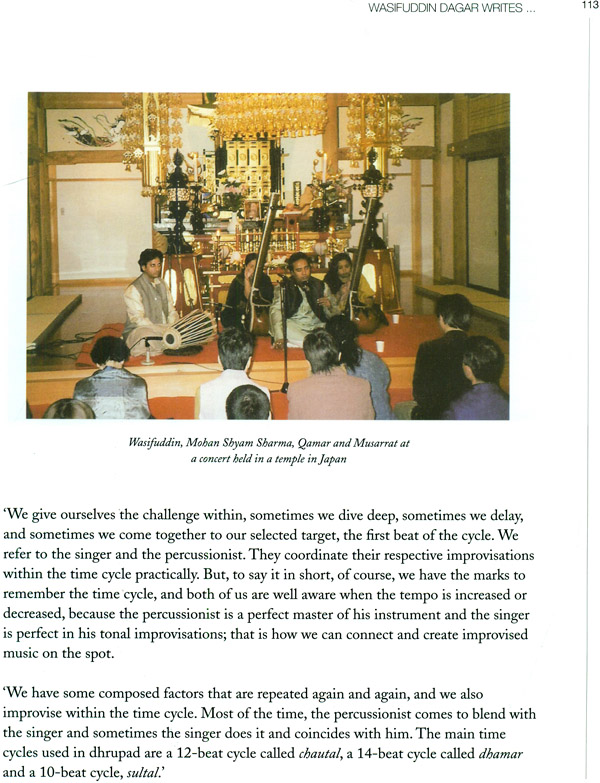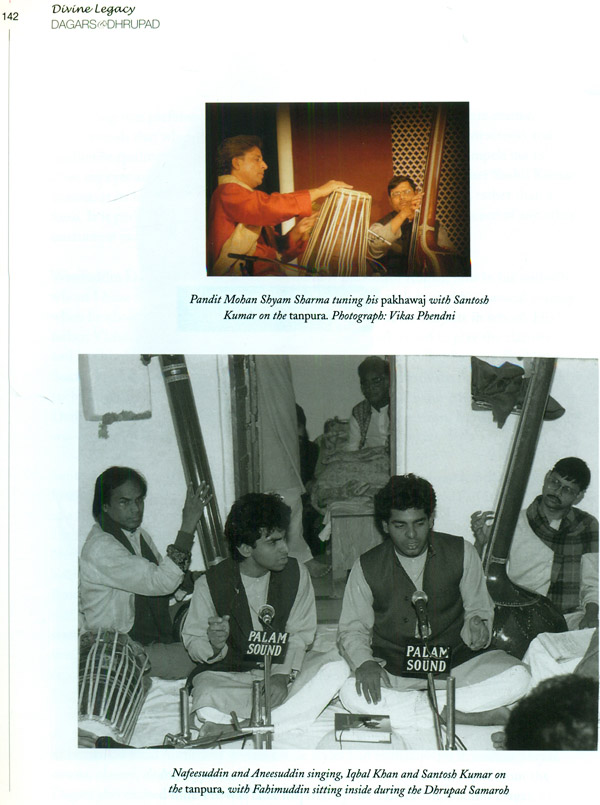
Dagars and Dhrupad
Book Specification
| Item Code: | NAK646 |
| Author: | Humra Quraishi |
| Publisher: | Niyogi Books |
| Language: | English |
| Edition: | 2015 |
| ISBN: | 9789383098750 |
| Pages: | 156 (Throughout Color Illustrations) |
| Cover: | Hardcover |
| Other Details | 10.0 inch x 9.0 inch |
| Weight | 810 gm |
Book Description
About the Book
Dhrupad is one of the earliest and most dominant streams that has contributed to Hindustani classical music. According to Faiyazuddin Dagar (1934-1989), 'In the two parts of the dhrupad, the alap [the improvised section of a raga, forming a prologue to the formal expression] is sung in free rhythm over drone, and the pada [word or phrase that signifies the concept of a raga] is more a rhythmic poem accompanied by drumming over the two-headed pakhawaj [the standard percussion instrument used in dhrupad]. It is a devotional and spiritual type of music ... and though the basic style has not changed right from the earlier times-15 centuries ago-individuality does come in and find its place.'
Dagars & Dhrupad: Divine Legacy gives glimpses of the rich heritage of this haunting form of music that has enthralled audiences worldwide. It traces the history of the illustrious Dagar family through 20 generations of dhrupad singers and highlights their distinctive approach to this unique form of music. Rare photographs make the book all the more special.
About the Author
Humra Quraishi is a Delhi-based writer-columnist-journalist. Her books include Kashmir: The Untold Story and a volume of her collective writings, Views Yours and Mine. She has co-authored two books with Khushwant Singh- The Good. The Bad and The Ridiculous and Absolute Khushwant.
Her take on what it is like to be a singleton in today's turbulent times is part of the anthology, Chasing the Good Life:On Being Single. And one of her essays, The State Can't Snatch Away Our Children forms part of the anthology, Of Mothers and Others. Her short story collection, More Bad Time Tales, was released in 2014.
Foreword
When Humra Quraishi suggested that I could pen a few words about this book on the Dagar clan and its contribution to the dhrupad musical tradition of India, I agreed readily enough as I imagined that I knew a bit of the terrain. The problem really dawned upon me once I realised that not only was the subject rather overwhelming in its vastness and complexity, but that it was quite difficult to separate truth from fiction when one was dealing with the 'first family' of one of India's oldest living traditions. And then, in my case, I had the additional issue of how to retain the chain of thought in the few late evenings that I could steal to pursue this delicious task, after my cerebral matter had been traumatised for the preceding 12 hours in a high pressure office. But, Humraji is not one to give up and I must compliment her first for not only selecting such a fascinating subject but also for badgering me on a daily basis, until this little tribute was done. My task is to try to set the context in which dhrupad was developed over the centuries by the Dagar family and the role that their talented scion, Wasifuddin, now performs.
For students and connoisseurs of Hindustani classical music, some icons are revered with the same passion and devotion with which this great tradition produces its ethereal notes and vocal renditions. At the crux of such profound and pure music, lies this sheer craving for being one with the divine. That is what has sustained Sufis, Vaishnavs and other devotees, to nurture Indian classical music for so many centuries. And among these icons are Amir Khusrau, Bhakti composers such as Kabir, Nanak and Meerabai, the legendary Mian Tansen who was the jewel in Akbar's navaratna sabha and then go right down to Sadarang of Mu ham mad Shah's court and maybe all the way to Awadh's Wajid Ali Shah, Vishnu Digambar Paluskar and Vishnu Narayan Bhatkhande. But where dhrupad is concerned, as one of the oldest and most powerful streams that contributed to Hindustani classical music, it is Raja Mansingh Tomar of fifteenth century Gwalior who is greatly revered. It was he who helped in the momentous shift from Sanskrit to the idiom of the common man, Hindi, and also in the development of dhrupad, on which we are presently focusing. One can safely assume that it was dhrupad that helped immensely in bringing the often wary and lay Hindu believer closer to the lofty grandeur of north Indian classical music, supported as it was to a large extent by Islamic rulers and their courts. It was practically an outreach programme of the aristocracy to build bridges with their mainly Hindu subjects, to whom it appealed quite significantly. After all, the songs were to the glory of their deities in the own sweet local dialect of the Yamuna-Dehlee-Mathura-Agra region.
The moot point here is that Indian classical music is inseparably intertwined with religion and if we look back, we can trace it to the Sama- Rig Vedic chanting tradition, then the two Vedangas, namely shiksha for the right pronunciation or chants and the chhandas for prosody. The Ramayana reflects this emphasis on music through raptures over Narada's genius and even goes to great lengths to extol Ravana as a great musician. But let us skip over the intervening centuries, the Natya Shastra, the Dattilam text, Kalidasa's observations and the twelfth century treatise, Sangita Makarandha and home down on Sharanga - Deva's Sangita Ratnakara of the next century. It is here that we get the early evidence of the Islamic presence, through todis such as the Turushka (Turkish). It marks the point from where the Carnatic musical tradition would focus on the refinement of Hindu devotional music in the Deccan, while Hindustani classical music would seek to synthesise the indigenous with Persian traditions such as Musiqi-e assil. It also assimilated several vibrant folk forms in the larger northern half of this vast subcontinent.
In this syncretic mission, dhrupad or dhruva-pada is the pillar of the Hindu faith that sang the prabhandas and Bhakti lyrics side by side with the Sufis as they tried to reach out to the Almighty with sheer devotional music. As Ms Quraishi explains in this book, dhrupad is considered to be the purest of all Hindustani forms as also the oldest. The very resonance that comes from deep within and permeates the total being of the singer represents not only years of practise and mastery of nada yoga, but also reverberates with a yearning, beseeching the blessings of the Lord.
Om Ananta tam Taran Tarini Twam, Hari Om Narayana, Ananta Hari Om Narayana Dhrupad songs usually begin with a long alap, with the recitation of this mantra, leaving no doubt that they are primarily and secondarily devotional in content and theme. The question that arises in the minds of the beginner is: how on earth is it that the Muslim family of the Dagars is the custodian of the richest and one of the oldest genres of Hindu religious music and that, too, for centuries? This is where Humraji traces the lineage right up to the Sanskrit lyrics that were the rage through the immensely popular medieval language of the masses, Braj-bhasha. Abul Fazl defined the dhrupad verse a bit clinically in his Ain-i-Akbari as 'four rhyming lines, each of indefinite prosodic length'. There is no doubt that whatever be the antiquity of this genre, we may agree with Pandit Ravi Shankar who felt that it flowered only in the fifteenth century as an improvement of the prabandha that it replaced. It was soon to be seated firmly in the Mughal court.
The family tree actually goes back to a Brahmin, Girdhar Nath Pandey, as its founder and he is said to have been a contemporary of Babar, the founder of the Mughal Empire. His grandsons, Gadadhar and Gyandhar, are contemporaries of Akbar and appear as Khan Dagars, namely, Masmad Ali and Surgyan. We meander through a century-and- a-half until we come to Baba Gopal Das or Baba Imam Baksh Khan Dagar, who is regarded as the founder of the clan.
We leave these appetisers for Ms Quraishi's more detailed work, to focus on the immediate past that belongs to two pairs of Dagar brothers who retrieved a tradition that had waned before the more spontaneous and creative khayal for almost two centuries. The 'senior pair' consisted of the elder sons of Ustad Nasiruddin, who excelled as the court singer of Tukoji Rao Holkar of Indore, namely, Nasir Moinuddin and Nasir Aminuddin. They burst upon the national scene in the latter half of the 1950s with their matchlessjugalbandis (duets) and their compositions for dance recitals and iconic ballets at the Shriram Kala 'Kendra. It was then that Alain Danielou 'discovered' them and introduced dhrupad as the original music of Hindustan to European and other Western audiences. As many are aware, this French historian, musicologist and Indologist fell in love with India and was associated with Tagore's Visva Bharati, the Benaras Hindu University's College of Indian Music and the Adyar Library and Research Centre in Chennai. Thanks to his unstinted efforts at UNESCO, where he was Advisor on the International Music Council, dhrupad was recognised and patronised, leading to several recordings and performances.
It is my personal submission that just two decades, the 1950s and the 1960s, contributed more to the popularisation of Indian classical music and dance than several preceding decades or even centuries put together. The seeds laid by stalwarts such as Tagore, Paluskar and Bhatkhande, in the early part of the century, would bear fruit in these decades. Pandit Nehru took personal interest in setting up the National Akademis for the Letters, the fine arts and, of course, for dance, drama and music. He even headed the Sahitya Akademi while his daughter, Indira Gandhi, chaired the Sangeet Natak Akademi from 1965. Panditji's worthy minister for Education and Culture, Maulana Azad, ensured that full justice and more was accorded to classical forms, as most of it represented centuries of fruitful cultural syncretism and was a fitting rejoinder to those who split the country on grounds of sectarianism. BV Keskar, the Information Minister in Nehru's cabinet, was passionate about shastriya sangeet and nritya-kala (classical music and dance forms), re-discovering old dying cultural practices and resuscitating them as well as encouraging others to come out of their traditional habitat to adjust to the modern proscenium stage. The state thus stepped in as the investor of the arts, as royal benefactors lost their clout and wealth in independent India.
To make his bias clear, Keskar even banned popular Hindi film songs altogether from Akashvani, so that classical culture could emerge from the narrow confines of temple natya-mandapams and haveli-kothi dance parlours to reach the masses and thus broaden their emotive association with their countrymen. It is another matter that this would lead to the 'sanitisation' of these art forms as the underlying 'disrepute' that hovered over heads of the traditional devadasi temple dancers and the courtesan was made to disappear as the 'brahmanical takeover' of (say) Bharata Natyam proved. More dance and drama forms were thus re-cast and given the highest recognition in these two decades. Classical music also reigned supreme not only as an accompaniment of dance performances, but also as a strong independent expression. The Akashvani Sangeet Sammelans and the prestigious soirees thus democratised classical music in a volcanic burst of energies. The Dagar brothers were naturally considered top grade artistes of the All India Radio, but other dhrupad schools such as the Darbhanga received support, as did numerous singers and pakhawaj players.
One may do well to remember that it is in this context that the 'senior' Dagar brothers achieved dizzying heights of national and international fame that their father, or uncles Rahimuddin or even Riazuddin of Jaipur or Ziauddin of Udaipur could never dream of The pair's influence was profound and their several disciples contributed immensely to the rise and revival of this ancient musical tradition. Their students included their own two younger brothers, the so-called 'junior' Dagar brothers, Nasir Zahiruddin and Nasir Faiyazuddin, who would uphold the glory of dhrupad. They continued to mesmerise audiences in India and abroad, as the mantle of the Dagar khandaan was now with them, once Moinuddin left the world. The 'junior' duo took dhrupad to different corners of the world to acquaint newer listeners to the subtle nuances of this devotional music, setting up the Dhrupad Society to formalise their mission. I treasure a rare photograph taken in Kolkata in the early 1980s where seven of the eight talented grandsons of Zakiruddin Khan and Allahbande Khan were playing together: what a sight to behold and what melody! There were Zia Fariduddin, Nasir Zahiruddin, Rahim Fahimuddin, Nasir Aminuddin, Zia Mohiuddin, Nasir Faiyazuddin and Hussain Sayeeduddin: each with his tanpura. The eldest brother of this generation,
asir Moinuddin, had died in 1966 at the peak of his career.
It was soon clear that Faiyazuddin's son, Wasifuddin, would have to be the major torchbearer of the unbroken lineage and this is what Ms Quraishi's book concentrates on. I leave the rest to Humraji and her narrative, which has been done with a lot of care. It is quite common for senior cultural personalities to be feted with awards, biographical books and documentaries, but by then they have reached their peak. It is my belief that Ustad Faiyaz Wasifuddin Dagar has years to go, even though he has proved his mettle right from 1989, performing with his illustrious uncle and guru, Ustad Nasir Zahiruddin. The uncle-nephew duo swept audiences all over the world and a French television company even made a film on them. After Zahir sahib's death in 1994, Wasif has been on his own, spreading and even improving upon the Dagarvani tradition, along with other endowed students of the Dagars such as Ritwik Sanyal in Benaras. But, I am sure that the best is yet to come, which is all the more reason for us to congratulate Ms Quraishi for undertaking this venture at this stage.
I have been acquainted with Humraji from my days as Culture Secretary and then in my present assignment in Prasar Bharati, when she was working very seriously on health issues for television. I have been amazed at the versatility and energy of her 'freelancing journalism'. It ranges from Kashmir, on which she has specialised, to Khushwant Singh, and she has already written books on both. We can be certain that her advantage of knowing Wasif's father Faiyaz sahib and uncle, Zahiruddin, rather well could lead to interesting anecdotes that we shall enjoy.
Introduction
I first attended a dhrupad concert in the mid-1980s, at the residence of the then envoy of Qatar to India, Dr Hassan Al Nimah. The setting was absolutely perfect. The two Dagar Brothers-Ustad Nasir Zahiruddin and Ustad Nasir Faiyazuddin-were singing under the white billowing shamiana (tent) erected on the sprawling lawns of the ambassador's residence. I was totally mesmerised. I had never ever heard such heady strains in classical singing ... there was something divine about their rendering; their voices were gentle, yet haunting. I felt I was being lifted to another level.
In 1986, Khushwant Singh had something similar to say about the Dagars and dhrupad: 'All my life I've been made to feel a lesser person because I have little understanding of the pakka raag [classical music]. I admit that despite strenuous efforts I can only identity four of the most easily recognisable ragas- Yaman, Kaafi, Bhimpalasi and some variations of the Megha. The sense of inferiority has got so engrained that I did not dare to express an opinion on the merits of the classical singers and concede that I am a low-brow who cannot appreciate anything more complicated than ghazals or qawwalis [forms of poetry]' The more pakka the fare offered, the more reluctant I am to accept it. I expect a large majority of music lovers have, like me, reconciled themselves to being consigned to the Vividh Bharati level of musical intelligence. Let me assure them that that there is nothing very esoteric about pakka raag and they need no special samajh [intelligence] to enjoy it ...
'It was my exposure to dhrupad, which is undoubtedly the most pakka of all our varieties of classical music-since the concert was arranged by Delhi's Cancer Patients Aid Association, of which I am an office-bearer and Lt. Governor Jagmohan had to inaugurate it, I was there to receive him. I thought that after Jagmohan had made his speech, he would leave and I would slip out with him. I suggested as much to him, as he had another engagement half-an-hour after the concert was due to begin. I also noticed that a vast majority of the audience in the Aiwan-e-Ghalib auditorium were foreigners who would soon tire of classical music.
'The Dagar Brothers began their dhrupad in Raga Bihag at a leisurely pace and slowly built up the tempo to its final climax. Jagmohan forgot about his next engagement. For the next hour we sat as though spellbound by the magic web woven around us by the Dagar Bandhu. The audience, mostly Europeans and Americans, gave them a thunderous ovation. For me it was an experience of a lifetime.'
That, indeed, is the magic of the Dagar Brothers and their music.
Contents
| Foreword | 3 |
| Introduction | 15 |
| What is Dhrupad? | 17 |
| Generations of Performers | 29 |
| Conversing with the Dagar Brothers | 49 |
| Death of a Legend | 63 |
| Passage of Time | 73 |
| Carrying on the Legacy | 95 |
| Wasifuddin Dagar Writes | 103 |
| The Dagar Disciples | 123 |
| Index | 153 |
